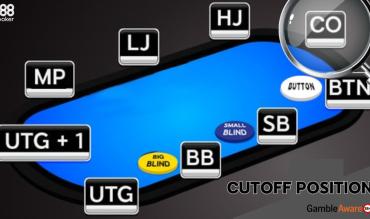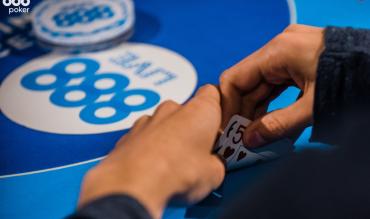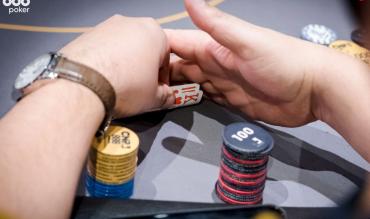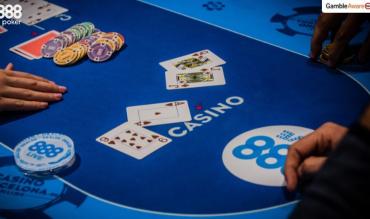What is the Cutoff in Poker? — Basic Definition
The cutoff position in poker is a specific seat at the table. The cutoff seat refers to your physical location.
So, a better question than "What is the cutoff in poker?" is "Where is the cutoff in poker?"
Where Is the Cutoff in Poker? — Finding Your Seat
Every seat has a name when you sit down at a poker table. The seats rotate with each hand, meaning every player will have the chance to play in each seat position.
These are the poker seat position names:
- Under the Gun (UTG)
- Under the Gun+1 (UTG+1)
- Middle Position (MP)
- Lojack (LJ)
- Hijack (HJ)
- Cutoff (CO)
- Button (BU)
- Small Blind (SB)
- Big Blind (BB)
Bottom line? The cutoff position in poker acts before the button.
(You can learn more about the poker seat names and their importance here in this article: Poker Positions Poker Explained: A Beginner's Complete In-Depth Guide).

Is the Cutoff Position in Poker Good?
Yes—the cutoff is the second-most profitable position in poker! (The button is the most profitable.)
Knowing where the cutoff position is located is essential when learning how to play poker.
Since you get to act after most of the other players, you get to see what they do first in front of you—a huge advantage.
- Do they bet?
- Do they raise?
- Do they fold?
By watching their decisions, you can adjust accordingly.
The button is the only seat position that follows the cutoff after the flop. The CO and the BTN are highly advantageous poker seat positions.
You get to see what the other players do first and can make better moves with that information. It’s a lot easier to navigate a hand if you know how many people are going to call a bet or how interested they seem in their cards.
Why Is it Called the Cutoff in Poker?
There are two common theories.
- This position at the table used to cut the cards for the dealer after the shuffle.
- The cutoff seat can ‘cut off’ the favourable position of the button by getting in an open raise.
These are just theories; no one knows where this position at the poker table gets its name. However, the second of the poker definitions clearly reminds you to make your move right before the button.
If no one has raised by the time it’s the button’s turn to act, the button might raise a speculative holding (think: junky cards). They realise that it’s unlikely anyone else has a very strong hand.

So, the theory goes like this:
- The button raises with medium or lousy cards because everyone else seems disinterested.
- The cutoff, aware of this plan, will ‘cut them off’ and raise first!
- (The player in the hijack seat, aware of the cutoff’s plan to cut off the button, will hijack the cutoff by raising before them!)
That’s why we have the seat sequence of hijack, cutoff, and button.
Is it Possible to ‘Steal’ from the Cutoff?
Another way to think of this raising metagame in poker lingo is as a ‘steal.’ Similar to the button, the cutoff in poker provides a good opportunity to ‘steal’ the blinds preflop by open-raising a wide range of hands.
Of course, stealing from the cutoff is not typically as profitable as stealing from the button. The risk that the button might ‘wake up’ to a very good hand still exists.
Even if the button's hand is only mediocre, if they decide to play, they will be 'in position' versus the cutoff throughout the hand. They will get to make decisions after watching what the cutoff does first—a critical advantage.

Which Hands Should We Open Raise in the Cutoff?
While it depends on the exact game, a typical cash game player will raise around 27% of starting hands from the cutoff. Depending on how we value them, this percentage will generally be the top 27% of starting hands.
You can find a chart with exactly which hands to raise in the cutoff position in poker here.
Note: If the players on the button and in blinds fold a lot preflop, a sharky player will expand their cutoff open-raising range, taking advantage of their opponents’ passivity.
How Should We Play CUTOFF When Someone Open Raises?
When in the cutoff seat, we should treat open raises with a measure of respect. Middle and early position open raises usually have a strong range.
A typical cash game player might cold call around 7% of the time and 3bet around 6% of the time. We should mostly fold in the cutoff when facing an open raise.
Generally speaking, if you’re unsure preflop whether to play a hand, you should lean towards a fold. Tricky spots—and mistakes—compound after the flop, especially if you have to navigate a wet poker board.
When in doubt, let it go! Fold.
What Is a Good Cutoff Winrate?
The cutoff winrate can vary based on the game format and a player’s skill level. However, in a standard cash game, a strong player typically aims for a winrate of around 24 big blinds per 100 hands (24bb/100).
If your winrate is significantly lower, it could indicate leaks in your strategy, such as poor hand selection, suboptimal aggression, or mistakes in post-flop play.

How Should We Play Against Cutoff Open Raises?
Cutoff open raises do not necessarily indicate massive strength (although they are undoubtedly stronger than button open-raising ranges on average). When facing a cutoff open raise, we should defend actively from the button, small blind, and big blind.
In other words, treat it with suspicion if someone open-raises from the cutoff. It's much scarier to raise from an earlier position, like under the gun, so those raises typically get much more respect.
If someone raises from the cutoff, it may be tempting—and a solid play—to reraise them and apply pressure from the button or even one of the blinds.
Remember how the cutoff got its name from scheming to cut off the button? They could be raising ‘light’—with weak cards—trying to pull a fast one.
Cutoff in Poker - Final Thoughts
The cutoff is the second most profitable seat at the table after the button, so it’s essential to know how to play from this position.
The cutoff can be especially profitable when the player on the button is overly tight giving us frequent access to the blinds.
For more specific advice on playing from the cutoff in cash games, why not check out this strategy guide to playing in the cutoff.


